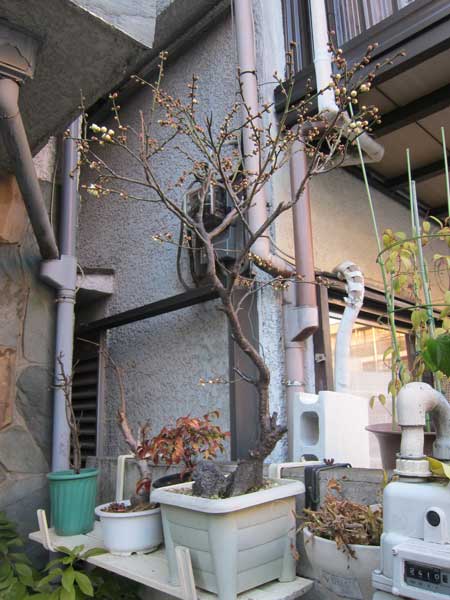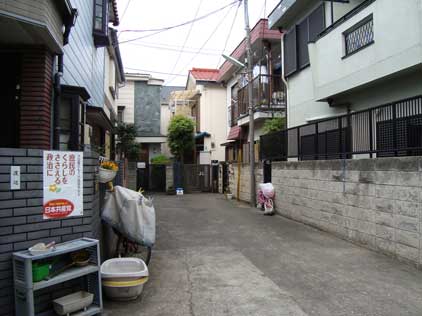
gardener
Reusing old wood to build a new fence

I’ve been wanting to rebuild my small back fence, and wondered about using recycled wood. Then I realized that I could reuse some of the old fence. Thanks to Kap, my amazing gardener, for rebuilding the fence using old materials turned from vertical planks to horizontal orientation.
Sunflower blooms next to the road, outside the gardener’s property
Interviewing neighbors for Plant Journal article about flower pot gardens

バルセロナの「plant journal」という雑誌が東京の植木鉢の庭について記事を聞きました。浜田大輔さんはフィルム写真を撮りました。近所の庭師たちをインタビューをして、楽しかったです。
Barcelona-based Plant Journal invited me to write an article about Tokyo flower pot gardeners, and arranged for Daisuke HAMADA to take film photos of the gardens I selected in Nakano and Shinjuku. I interviewed two older gentlemen whose gardens I’ve long admired.
Hamada-san’s fantastic photos inspired me to buy a film camera, and in a few weeks I’ll start posting from my first roll. I think it’s been nearly twenty years since I had a film camera.
Plum bonsai in tiny but abundant home garden

梅の木の盆栽が小さくて豊富な庭に置かれました。中野駅の途中にあります。植木屋さんは季節と植物をよく知っています。植物が植木鉢で育っているので、いろいろな楽しみのために移動しやすいです。
This plum bonsai is part of a tiny but incredibly abundant garden also on the way to Nakano station. This gardener clearly knows about plants and seasons. Because almost all his plants are in pots, they can be moved around for maximum enjoyment.
Year round flowers in Tokyo

東京には四季があるけれど、冬も花がよく見られます。駅に行く途中で、この白色のツバキの前を通ります。庭が小さいのに、いっぱい植物を育てていて、どの季節もきれいです。
I like how Tokyo has four seasons, but even in winter there are flowers. This well trimmed camellia is part of a wonderful residential garden that I pass on my way to the JR station. The space is small, but the gardener has dozens of species that are attractive in all season.
Woody and stylized nature at Shinjuku Gyoen

どんな理由があっても、新宿御苑を通り抜けるのが大好きです。植物と景色が多いです。モミジが池に映っていて、人のいない自然みたい。竹で作られた柵があるから、人が作った場所だと分かりますが。近くに日本庭園があります。園芸家のおかげで、様式化されています。両方の景色が好きだから、一緒に見るのはすばらしです。
With any excuse, I like to cut across Shinjuku Gyoen. There are so many different plants and landscapes to see there. I like the contrast of these photos. Above late summer maple trees are lush green, and reflected in a pond. Only the wooden edge suggests that it is a garden and not a natural wonder. Below is the Japanese garden, with a path through the pond and gardeners hard at work styling nature into a very specific shape. I love seeing both woody and stylized versions so close to each other.

Grapes growing on a busy sidewalk

These grapes are growing in the narrow space between the sidewalk and a wide road in Oimachi. I like how this local gardener has adapted the city’s railing, and added additional height and support.
Fairy white brings Australia to Tokyo

This is the second year that I am growing this beautiful daisy-like cream flower with very soft leaves, Actinotus helianthi, known in Japan as “fairy white” (フェアリー・ワイト). I think it’s odd that a plant that is iconic of Sydney, Australia, where it is called Flannel plant, does so well in Tokyo. My San Francisco gardener friend Hank was amazed to see it in Tokyo. The Wikipedia page suggests it likes well drained soil, so perhaps it was destined to be a potted plant!
Fall perennial border in pots on curbside

I love this fall perennial border despite the lack of ground soil and space. Fifteen to twenty pots contain flowering ornamentals on the narrow curb between an Asagaya residence and the small street. The garden is very complete and very public. I admire the gardener’s generosity to passing pedestrians and bicyclists.
Ivy trained into an X-shape topiary

I love how this ivy has been trained into a perfect X-shape topiary. Clearly following the form of the steel support for the apartment building’s facade, the tidy and even pruning also demonstrates the gardener’s on-going care. This local person must enjoy plants and the opportunity to make something artful in a small space.
Japan’s Ministry of Foreign Affairs

Last week I gave several talks about Tokyo Green Space, including at Japan’s Ministry of Foreign Affairs (Gaimusho, 外務書). The 1960s modernist building and landscaping impressed me. You can see the bright yellow ginkos in the background and the last fall leaves in the foreground.
My main point to the Ministry was that Japan has not done a good job of explaining its accomplishments in creating livable cities. Both its ordinary gardeners who compensate for a history of poor planning, and its landscape visionaries who are creating new public spaces for people and wildlife are unknown within and outside Japan. Most foreigners are surprised at how human-scaled and enjoyable Tokyo is.
Given climate change and global urbanization, Japan should promote its achievements and expertise in new urbanism, with relevance to developed and emerging cities around the world.
I also gave talks last week at Hitachi Ltd Headquarters to an audience that included Hitachi global business, defense systems, environmental strategy, and research institute leaders, as well as Kajima and ARUP biodiversity specialists, university professors, and Japanese media. Voted the MVP (most voted person), I also gave an impromptu speech, in Japanese, at the wonderful TEDxSeeds conference organized by the extraordinary culture curator Satoh Keiko.

Speaking at Anthropology of Japan in Japan conference

This weekend I will be presenting a talk, “Urban Gardeners and the City of the Future,” in an Urban Japan panel at the Anthropology of Japan in Japan conference. It will be held at Temple University‘s Japan campus, and my panel is Saturday November 7 from 1 pm to 3 pm along with papers on urban bicycling, geisha, street festivals, and gender inequality.
This year is a tribute to Stanford Anthropology Professor Harumi Befu, a scholar of Japanese identity, nationalism and globalization. The conference theme is “Civil Society and Citizenship in MultiNational/MultiCultural Japan.”
Two young Nodai alumni

During the Tokyo University of Agriculture’s fall festival, the Garden Design Lab of the Landscape Architect Sciences department hosted a reunion for alumni under 35. I met two fascinating alumni who had studied at Nodai in the late 1990s. Alumnus Suzuki Hokuto (鈴木北斗), has a shop called Kyouen Store that sells traditional Japanese gardeners’ clothes and supplies, made of denim and using a special dye that repels mosquitos. There are even cool explanations of the different components, including tabi, kyahan, jyouba, harakake, momohiki, koikuchi, and tekkou. The site is in Japanese but the photos give you a good idea of what the clothes look like. The photo above is jyouba and below tekkou, which I have seen Kobayashi Kenji Sensei of Sinajina use. His landscape design firm is Kyouen.

I also met Satou Koutarou (佐藤光太朗), who has a landscape business Iloha 1128 and also creates art from unbaked soil. It seems related to ceramics but somehow is not fired. He has a cool blog, and a gallery of his art work.

Dead space by design

Tokyo Green Space celebrates the ingenuity of people who create greenery in a city that is often poorly planned, dominated by concrete, and overly paved. However, it is worth pointing out the prevalence of dead spaces by design, often created by local governments and even Tokyo Metro.
Above is a nearly brand new elevator providing access to the Shin Nakano Marunouchi station of Tokyo Metro. The elevator occupies an odd shaped and small space between a road and parking lot, and between a pachinko parlor, a large apartment building and a busy street. Next to the rectilinear elevator and covered entrance is a sizeable triangular area bordered by a brown colored metal fence.
Clearly, the Metro does not want people to park their bikes in this small area, and is probably pleased that they have accomplished this goal. However, the fence has made this centrally located land a dead zone. So many other uses could be made with that space: a tree or two, a bench, a vegetable garden, a food cart, newspaper stand, a bulletin board for community events. Given the amount of local gardeners, I am certain that the Metro would not need to maintain the space with their own staff.

A similar dead triangle zone was created between a pedestrian path and a small street. Again, the design goal is to prevent vehicles from entering the pedestrian path (in the foreground with white tiles on the ground). Here, too, the brown metal fence creates a triangle of deadness, where the yellow and green poles would have seemed adequate for the job.
If the brown metal fence was not there, the space could also be used for much needed shade, a fruit tree, a community garden, or a bench. The creation of these dead spaces by government authorities suggests a lack of imagination and awareness.

Finally, this space between houses and apartments is filled with concrete, and apparently unused. It is unclear whether the space is public street, individually owned or somehow shared space between neighbors. In any case, it is a wasted opportunity for greenery and community.
